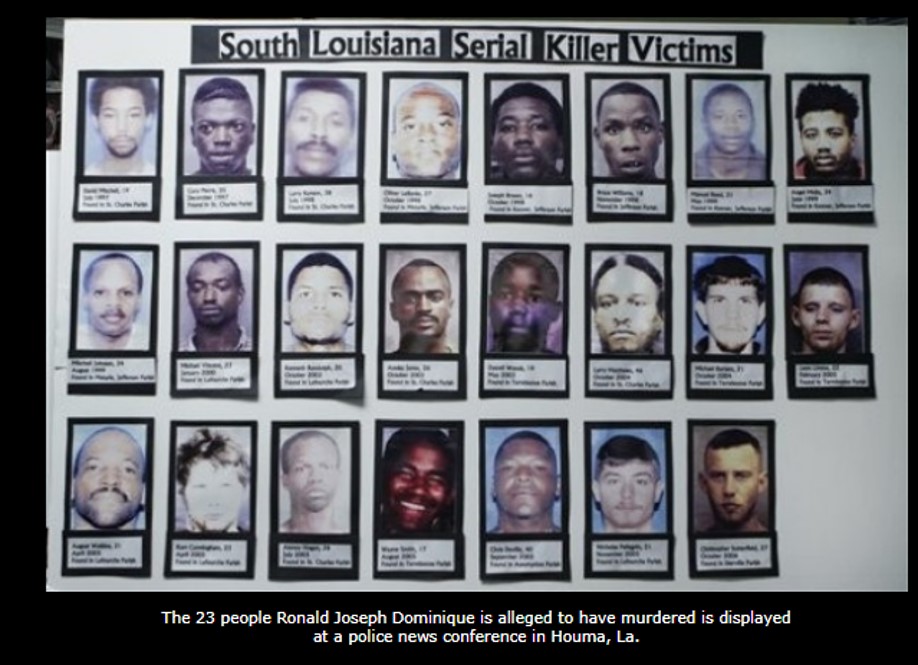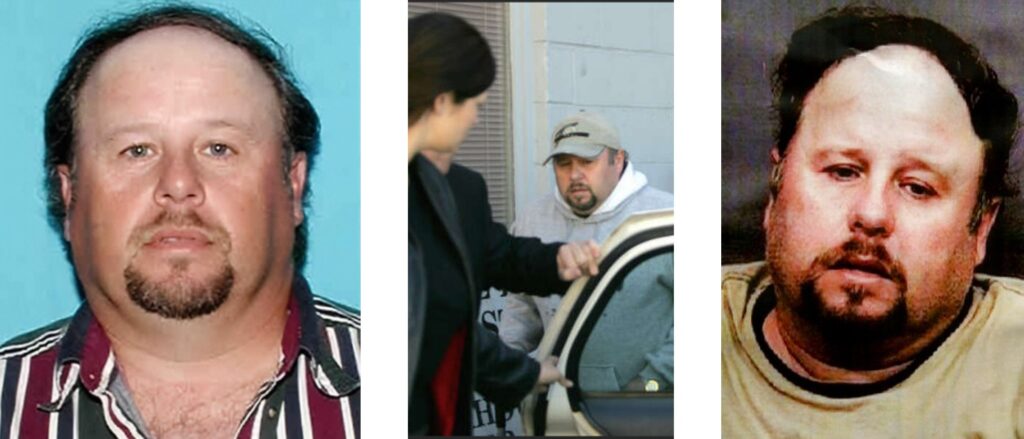
Investigation Reports. Ronald Dominique, the Bayou Strangler, deceived, bound, raped, and strangled 23 innocent young men to death. He preyed on unsuspecting male victims, then disposed of their bodies like trash.
This serial killer chose random, dark locations to dump 23 men after he lured them, sexually assaulted them, and murdered them between 1997 and 2006.
Detectives said Dominique targeted victims along Louisiana Highway 182 near low-budget motels known for drugs and prostitution, as well as the Mechanicville neighborhood in East Houma. The depth of his murders reached as far as New Orleans and several other parishes: St. Charles, Jefferson, Lafourche, Assumption, and Iberville.
A serial killer was operating under the radar while robbing young men of their lives. He had worked as a pizza deliveryman and meter reader.
The public was unaware of most of these murders until years later. The majority of these young men were Black. There was minimal news media coverage of the dead men. Perhaps not newsworthy.
According to authorities, Dominique propositioned his victims for sex or lured them with the promise of drugs or sex with a fictitious woman.
He tied the men up and raped them before strangling or suffocating them, police reported. The bodies were found in cane fields and near remote bayous across south Louisiana.
Despite previous run-ins with the law, Ronald Dominique continued living in his trailer park community with little to no issue; the community hardly noticed him.
Dominique appeared harmless. He was an overweight man, stood at just five-foot-five, lived with his sister, and walked with a cane. Who would suspect him?
His meek demeanor may have been a rouse to cover up his crimes. Nonetheless, he was capable of horrific acts. Even before he would commit some of his most heinous crimes, he would almost be locked up.
In August of 1996, shortly after his DUI arrest, Dominique was arrested and charged with forcible rape.
A Killer Among Us (Houma Times)
In 1996, neighbors reported a near-nude young man leaping from the window of Dominique’s home, then screaming for help in the street and saying that Ronald had just tried to kill him. He had allegedly coerced a man into coming home with him and attempted to tie him up. When the man refused, Dominique became violent. Cops arrested Dominique.
But when Dominique was brought to trial, the victim was nowhere to be found to testify against him. Ultimately, the case was dropped, and Dominique determined he could never return to jail. He would later say that was why he had to kill his victims instead of getting caught.
Shortly after this trial ended, David Levron Mitchell, 19, turned up dead in early 1997. As he had done before, Dominique talked young David into coming home with him. He tied him up too, but this time succeeded in both raping and murdering his victim. Ronald Dominique then dragged the body out to a sugarcane field and left it there.
With the rape and murder of David Mitchell, Dominique began a nine-year killing spree.
In December, Gary Pierre, 20, was found dead. He had been sexually assaulted, strangled, tied up, and dumped like trash.
In July 1998, another body was found in St. Charles Parish. The killer was covering his tracks.
During his killing spree, Ronald Dominique was not a suspect in these crimes. He would leave bodies in various Parishes. He would go unnoticed as a serial killer. There was no evidence. Most of his victims were young Black men. Local authorities did not link the murders to a possible serial killer in Louisiana.

Oliver LeBanks was 26 years of age at the time authorities found his body on October 5, 1998, in Metairie. According to Dominique, they had met in the French Quarters at a bar and had agreed to have sex in the back of his car. He choked him, raped him, and dumped the body. Police would find Caucasian hair on his body.
Reed was found on May 30, 1999, six months after LeBanks, in nearby Kenner. He was 19 years old at the time.
Authorities said LeBanks and Reed were found strangled, both without one shoe, shirtless and in remote areas. Similar killings had been discovered as far back as 1997, police said.
Shortly after that, someone found the corpse of Larry Ranson, 38. The bodies just kept coming. All the victims had been strangled or suffocated, and most appeared to have been raped before being dumped in a sugar cane field, a marshy bayou, or a random ditch.
In 2004, Michael Barnett was found dead. He was the first known White male victim.
In March 2005, law-enforcement officers from nine south Louisiana parishes assembled a task force to hunt down what they correctly concluded was a serial killer at work.
In August 2005, Wayne Smith, a 17-year-old Black man, was found discarded like trash.
“The fact that we had little forensic evidence and the fact that the victims generally did not know the suspect complicated the case,” Forest said.
“The majority of victims lived a transient lifestyle; a lot of them were homeless and involved in illegal drug activity. When Dominque came in contact with them, it was mostly on the streets,” she added.
In September 2005, the investigation was derailed due to Hurricane Katrina—residents were evacuated—and the case shut down for about six months.
Thus far, Dominique had gotten away with multiple murders, but that was about to change.
The Federal Bureau of Investigation would be looped in as the body count increased. According to Jim Bernazzani, the Special Agent in charge, FBI profilers at the time considered Dominique’s case the most significant in terms of the number of victims he had acquired in such a short period.
Multiple links were made between the 23 victims, including missing articles of clothing, the cause of death, the location of where the body was found, and the high-risk lifestyles tended to be similar, according to authorities.
Most of these men he picked up at gay bars or off the streets where they stood at night prowling for johns. Others, he would show photos of an attractive woman and boast that she was his wife and that the men could come back to his house and have sex with her even though Dominique wasn’t married.
Once at his home, he would tie up his victims and rape them and, in most cases, kill them. Dominique told police during his arrest that if the men refused to be tied up, he would let them go unharmed.
His decision to let one man go would finally spell the end to his murder streak.
Almost 10 years after his fateful first murder, one of the men Ronald Dominique allowed to go free, an ex-con living in a homeless shelter, mentioned his close call to his parole officer.
In November 2005, a young Black man was approached by a white man who tried to tie him up. After escaping without incident, he reported it to the police. He brought the deputies to Dominique’s trailer. However, they found no evidence. He consented to giving a saliva sample to avoid suspicion.
Dominique had voluntarily agreed to a swab DNA test and was initially interviewed several months ago. Genetic testing from the swab matched evidence found on the bodies of LeBanks and Reed, and authorities began to build a case against the Houma man, the sheriff said.
Strong leads and what Les Bonano, head of investigations for the state Attorney General’s office, called “old-fashioned police work” brought Dominique’s name to the forefront. Bonano said the suspect had been under police surveillance for an “extended amount of time.”
Police launched a surveillance operation to watch Dominique, but they couldn’t watch him 24/7. Even though he knew he was under investigation, he continued to lure and kill.
October 2006—Christopher Sutterfield, a 26-year-old White male, was found dead. He would be Ronald Dominique’s 23rd victim.
November 2006—Dominique had checked into a homeless shelter with other men and women.
Officers arrested 42-year-old Dominique on December 1. He confessed to the 23 murders and, as Terrebonne Parish Sheriff Jerry Larpenter put it, “He stated how, when, and where they were killed.” He showed no remorse and blamed the victims.Dominique said he targeted men who appeared desperate—drug addicts, prostitutes, and the homeless. He trawled gay bars for victims and offered money for companionship. If he thought a potential target was straight, he’d show a picture of a woman he said was his wife and propose they have a threesome. Upon getting a man home, Dominique would break out a rope or other restraints, claiming it was part of a sex game. Once he had the victim bound, Dominique proceeded to commit sexual assault and then either choke or smother his helpless victim to death. Forensics connected Dominique to eight of the unsolved killings—the ones for which he eventually got eight life terms. The total number of community members Dominique took from those seven rural parishes proved devastating, though. As one officer put it: “We don’t have that many homicides in a year.”
Ronald Dominique was incarcerated at the State Pen in Angola. He is slated to die there.

Bayou Blue Recalls Serial Killer (Houma Times)
Dominique was arrested on December 1 at an East Houma homeless shelter on warrants for the murders of two men whose bodies were found in Jefferson Parish in the late 1990s.
He checked in like anyone in need, but Sgt. Bobby O’Bryan, owner of the Bunk House Inn in Houma, had no idea what was in store when Dominique walked through the doors that afternoon.
The Bunk House typically has an emergency occupancy regulation, allowing visitors shelter until 8 a.m. the following day, but when O’Bryan was confronted by a multi-agency task force looking for a possible serial killer, he issued Dominique a dormitory room where he could be watched by camera surveillance.
“We happened to have a room available, which was the safest place to put him. It was a private room in the back, so he was isolated from other people staying here,” said O’Bryan.
After his arrest, Dominique allegedly told investigators that he killed 23 men over the past 10 years and left their bodies on back streets in suburban New Orleans and in remote cane fields and shallow drainage canals in Terrebonne, Lafourche, and surrounding parishes.
Dominique took a Plea Deal to Avoid the Death Penalty
Dominique pleaded guilty to murdering eight men in Terrebonne Parish—Michael Barnett, Kurt Cunningham, Chris Deville, Alonzo Hogan, Leon Lirette, Nicholas Pellegrin, Wayne Smith, and August Watkins.
After Dominique’s arrest, people from all over the United States contacted the Terrebonne Parish Sheriff’s Office to report unsolved cases about their loved ones and to determine whether there was any connection to Dominique.
A grand jury ruled that there was enough evidence to prosecute Dominique in Terrebonne Parish for the murder of nine men he allegedly killed inside the parish limits. In late December, Jefferson Parish prosecutors dropped their charges against Dominique. They said his confession indicated he killed those two men in New Orleans, not in Jefferson Parish, effectively moving those cases to Orleans Parish.
Foret said detectives could not connect him with any cases outside of Louisiana.
Donations to Support This Site Are Always Welcome

Louisiana’s Most Prolific Serial Killer—World’s Most Evil Killers (YouTube Video)
Bayou Blue is available on Amazon Prime Video.
The Bayou Strangler: Louisiana’s Most Gruesome Serial Killer by Fred Rosen (Amazon Books)
The true story of Louisiana serial killer Ronald Dominique’s ten-year murder spree, the young men he slayed, and the detectives who hunted him down. DNA evidence finally linked the murders to a suspect: the unassuming Ronald Joseph Dominique, who had lived under the radar for years, working as a pizza deliveryman and meter reader.
Related: How South Carolina Investigators Discovered a Serial Killer Hiding in Plain Sight
How Authorities Finally Captured a Serial Killer in Southern Louisiana
ADD COMMENTS BELOW
- Moving and Relocating to Atlanta: How to Find Your New Home
- Money Matters: Insider Tips to Buying a Home
- Renting vs Owning a Home
- 3 Powerful Benefits of Using Managed WordPress Web Hosting
- Ways to Build Positive Credit
- Do It Yourself Credit Improvement Process
- Guides to Backpacking, Mountain Biking and Hiking Georgia
- How to Create an Ergonomic Workspace at Home or Work
- Backpacking, Hiking, and Camping Safety Guides
- A Trail of Clues to the Murder of Nicole Brown Simpson
- How Centra Tech’s Bitcoin Cryptocurrency Scheme Was Hatched and Discovered
- Starting a New Business as a New Mother: Tips for Thriving
- Balancing Success: Practical Self-Care Strategies for Entrepreneurs
- Guides to Backpacking and Hiking the Carolinas
- Guides to Hiking New York State and New Jersey
- Guides to Backpacking and Hiking Canada
- Guides to Hiking California and Nevada
- Email Marketing Campaigns for Small Business Owners
- The Tragic Murder of Rebecca Postle Bliefnick
- How a Grad Student Murder Spotlights Female Joggers’ Safety Concerns
- How Massive Commercial Financial Fraud Was Discovered in Singapore
- Guide to Martha Stewart’s Hugely Successful Concept and Art of Presentation
- Did Billy Ray Turner Conspire with Sherra Wright to Kill Former NBA Player Lorenzen Wright?
- How Operation Rebound’s 7-Year Cold Case was Finally Solved
- Stylish Outdoor Fire Pits and Patio Heaters
- Mastering DIY Marketing: Essential Skills and Strategies for Small Business Owners
- Great Deals on Snug UGG All-Season Boots
- How a GeoLocation Expert Tracked a Killer
- Transgender Law Enforcement Officer Denied Medical Coverage for Gender Dysphoria
- How Video Surveillance Cameras Helped Identify and Track a Killer
- How Investigators Solved the Murder Mystery of Army Sergeant Tyrone Hassel III
- How a Love Obsession Led to the Brutal Murder of Anna Lisa Raymundo
- How Stephen Grant Tried to Get Away with Killing His Wife
- How Unrelenting Catfish Schemes Led to Fatal Suicide
- How Pain Clinic Owners Turned Patients’ Pain into Enormous Profits